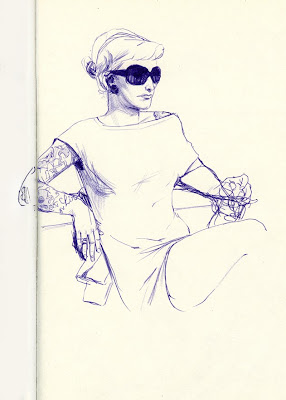
Fantastic Composition resource --Fundamentals of Composition Part 1 (scans from a 1950's artists book--proves there is no age limit on good design!) Don't forget to clicl the link towards the bottom for part two!
Instructions for stitching together multiple scans in Photoshop CS4:
Scan the different parts of your image, making sure the scans overlap a bit, and save them all in one folder.
With no files open in Photoshop, choose File > Automate > Photomerge.
In the Layout area, select Auto. Then, in the Source Files area, click Browse and navigate to the folder with your scans, select them all, and then click Open.
At the bottom of the Photomerge dialog box, select Blend Images Together, Vignette Removal, and Geometric Distortion Correction. Then click OK.
Photoshop creates the blended image--you may have to wait a bit. Photoshop finds the overlapping areas of the images and matched them,--they're all on separate layers, so you may want to flatten them all or merge down.
Texture & Flat Color artists (good color inspiration too):
A. Richard Allen
Jon Klassen
Tadahiro Uesugi
Meg Hunt
Good Poster Resources: International Poster Gallery and Gigposters.com
Class Assignment:
5 sketches for your Valentine's Day Event Poster! Sex at the Zoo, or Love Under the Sea. (for the Baltimore Zoo & National aquarium, respectively) Including the title is optional! Remember, thumbnails first, THEN pick your best ones to make into sketches. (and remember, make a box/ rectangle around the sketches)
At least TWO of your sketches cannot involve any hearts or cliche valentine imagery! For the other 3, you don't have to use hearts/imagery, but if you do I stress JUDICIOUS use. Think of different ways of connoting a valentines event--color, situation, mood. This assignment will eventually be completed in illustrator, which we will have a demo on next week! No animals or fish having sex, please.
Blog Assignment:
8 5-minute (or more) observational drawings of people or environments. I don't want to see a bunch of closeups of objects--focus on a scene or person-anatomy. (watching a movie can be good for this too--pause at a scene for 5 minutes and draw it)
The catch: You CANNOT use line! Sometimes you may have to--like the light coming through blinds or the dark space under a door, etc., but I want you to use shadow/light, and/or shape/color to define everything else. Sometimes looking at your subject with squinted eyes helps you see the shape of things. Break out your charcoal/ink/paint/whatever you prefer! Don't forget to draw a box/rectangle around 'em!
More along the lines of this, tonally:

Instead of this:

Both sketches copyright the talented Jens Claessens


No comments:
Post a Comment